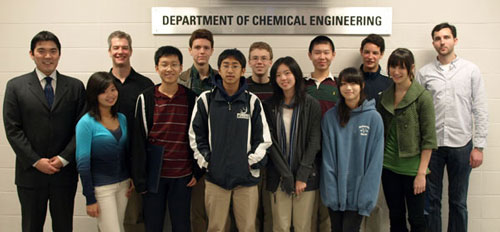User:Tommie Hata/2010 Pingry S.M.A.R.T. Team
From Proteopedia
| Line 15: | Line 15: | ||
== Cofactor specificity == | == Cofactor specificity == | ||
'''Modifying cofactor specificity, 2,5-diketo-d-gluconic acid reductase''' | '''Modifying cofactor specificity, 2,5-diketo-d-gluconic acid reductase''' | ||
| - | <applet load='1a80' size='300' frame='true' align='right' caption='Insert caption here' /> | + | <applet load='1a80' size='300' frame='true' align='right' caption='Insert caption here' scene name='User:Tommie_Hata/2010_Pingry_S.M.A.R.T._Team/1a80-default/1'>TextToBeDisplayed</scene>/> |
== Substrate specificity == | == Substrate specificity == | ||
Revision as of 20:05, 24 December 2009
Contents |
2010 Pingry S.M.A.R.T. Team, Protein Engineering; AKR's for Biofuel Cells
The 2010 Pingry School S.M.A.R.T. Team (Students Modeling A Research Topic) is working with Scott Banta at Columbia University to learn about enzymes being engineered for use in biofuel cells. Features being engineered into these enzymes include (1) self-assembly into hydrogels, (2) alternate cofactor use, and (3) broader substrate specificity. AdhD alcohol dehydrogenase from the thermophile Pyrococcus furiosus is one of the enzymes being engineered with these features by the Banta Lab. AdhD is a member of the aldo-keto reductase (AKR) family of oxidoreductases. Taking advantage of its innate thermostable properties, the Banta Lab is engineering AdhD for use in biofuel cells.The logical design and engineering of AdhD is based partially on the solved structures of other enzymes belonging to the AKR family of enzymes. Structures of mutants that bind alternate cofactors and those bound to its substrate provide insight into how to engineer AdhD and other enzymes of use in a biofuel cell. The 2010 Pingry S.M.A.R.T. Team is producing physical models of various AKR's that highlight the enzymes' structural and functional characteristics that are relevant to the Banta Lab's work.
What are S.M.A.R.T. Teams?
"S.M.A.R.T. Teams (Students Modeling A Research Topic) are teams of high school students and their teachers who are working with research scientists to design and construct physical models of the proteins or other molecular structures that are being investigated in their laboratories. SMART Teams use state-of-the-art molecular design software and rapid prototyping technologies to produce these unique models." -from the MSOE Center for BioMolecular Modeling Website.The S.M.A.R.T. Team program was supported in part by Grant Number 1 R25 RR022749-01 from the National Center for Research Resources (NCRR), a component of the National Institutes of Health (NIH), awarded to the Center for BioMolecular Modeling.
AdhD and Self-assembly into hydrogels
Cofactor specificity
Modifying cofactor specificity, 2,5-diketo-d-gluconic acid reductase
| |||||||||||



